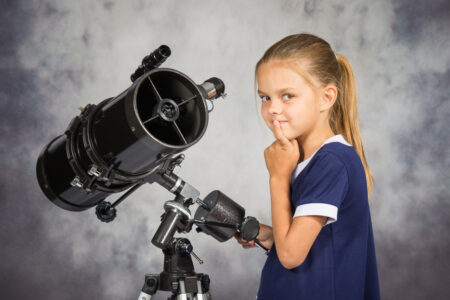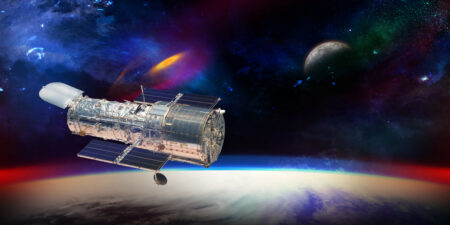Space Telescope, the James Webb, will soon be mapping the pathways to future exploration for future astronauts. Be sure you read and review the previous article so you can better enjoy the technology we will share with you in this story.
As we stated in Part I, the giant space telescope will be launched into space on Dec. 18. It will see the stars and indeed, entire galaxies in new ways. You most likely know about the Hubble and how it sees by utilizing its amazing optical and ultraviolet abilities. Now discover a new way of seeing and–new light to see, with the JWST (James Webb Space Telescope.)
Seeing “Redshifted” Light Through the JWST

Who Knows What Future Optics, Like Those On The Space Telescope, Will Bring?
In brief, the two space telescopes “see” in completely different ways.
- On the one hand, Hubble sees in optical and ultraviolet light wavelengths.
- On the other hand, the JWST will observe the universe in infrared. This special type of infrared sight is very necessary to space exploration. Additionally, the reason is that “light from distant objects shifts to longer wavelengths at the redder end of the spectrum — known as redshifted, according to ESA.”
And thus, JWST (James Web Space Telescope) will teach us about the oldest stars, because it can “see” far more distant celestial objects than the Hubble could observe.
2 Space Telescopes on 2 Different Paths
You might be surprised to know that the James Webb Space Telescope and the Hubble Space Telescope orbit different paths. “JWST will orbit the sun, whist Hubble orbits Earth.”
We are a little sad that the JWST won’t be serviced by the space shuttle. It will be too far away. Whatsmore, the James Web Space Telescope will always be too far away for astronauts to visit. However, our space shuttle missions consistently access the Hubble for servicing.
Webb’s tenure as NASA administrator is most closely associated with the Apollo moon program. However, he is also considered a leader in space science. Even in a time of great political turmoil, Webb set NASA’s science objectives, writing that launching a large space telescope should be a key goal of the space agency.
Where is the Telescope Now?

Because of Our Optical Developments in Space Telescopes, She Will Grow-up, Knowing More About the Universe Than Any Generation in History.
The JWST has recently arrived at Pariacabo harbor in French Guiana. ESA and NASA are working together to get it ready for its launch. It will ride on an Ariane 5 rocket to its far-away orbit.
The Ariane 5 is a truly international accomplishment. It partners with the US, the European Space Agency, and Canada. Everyone has been awaiting the arrival of the ocean transporter vessel for many months.
Meanwhile, the gigantic telescope left California on September 26th. It traveled through the Panama Canal and then to Port de Pariacabo. Thus, it arrived in French Guiana, on October 12th. Now it must travel to its launch site in its very own gargantuan suitcase.
Going to the Stars with STTARS
Even the suitcase is so special it has a name. It’s called STTARS. This is short for Space Telescope Transporter for Air, Road, and Sea.
- STTARS weighs in at about 168,000 pounds (76,000 kilograms).
- It’s the biggest packing crate we ever saw. It is 18 feet (5.5 meters) high and 15 feet (4.6 meters) wide.
- It measures an amazing length of and 110 feet (33.5 meters) long. That means in its entirety, it’s “about twice the length of a semi-trailer.”
A Telescope to Go Where “No Man Has Gone Before”

The Hubble: More of a Comrade Than a Competitor to the James Webb.
In summary, that makes it the “largest, most powerful telescope ever launched.”
Thus begins the James Webb Space Telescope’s quiet journey. The mission: to discover “how the first stars and galaxies formed roughly 13 billion years ago.” This quote came from Marcia Rieke, a professor at the University of Arizona, Tucson.
She has been the principal investigator for Webb’s near-infrared camera, known as NIRCam. Additionally, she added, “The JWST will be studying …atmosphere of early planets. That’s within our grasp now,” said Rieke. She also made us a couple of very optical commitments.
A Million Mile Mission on a 10 Billion Dollar Ticket
She said, “We will be able to see what happens to starlight when it’s absorbed into an exoplanet’s atmosphere.” Currently, we can only imagine. And she promised, “This time next year, we will have some gorgeous stuff to show you…”
We assure you, our readers, that ER Precision Optics will be watching and bringing you the news. After all, to create this project from scratch today would cost us 10 billion dollars.
To Whom Roses are Due: World Class Companies

Mankind Has Long Looked at the Light in the Sky. Now, Space Telescopes Can Explain What We Are Seeing.
We hereby congratulate many of the companies who helped create the James Webb Space Telescope. Kudos to Northrup Grumman, the company that excelled as the prime contractor.
Additionally, Ball Aerospace gets high praise for its work on the telescope as well as the following contributors:
- Likewise, we complement Lockheed Martin who was the subcontractor for the NIRCam.
- We also must mention ITT Inc., of Rochester, NY. They had the honor of creating the testing equipment for the optics of the gigantic telescope.
- And we must not neglect honors for Teledyne, the company that created the near-infrared detectors.
“The ten billion was worth it,” Rieke said. “If it works, it’s really going to change our view of a number of things in the universe. It will discover things that we couldn’t even guess right now. That’s part of the fun of it.”
As always, ER Precision Optics thanks you for reading our blog. We strive to bring you the latest and greatest news and information from the world of optical technology.


